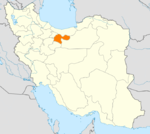- Malik National Museum of Iran
-
Malek National Library and Museum Country Iran Type National library, Public library Location Tehran Collection Size 19000 manuscripts
70000 booksCriteria for collection manuscripts Other information Director Seyed Mohammad Mojtaba Hosseini Website http://www.malekmuseum.org References: Hamshahri Newspaper
Malek National Museum and Library[1] is a museum and national library in Tehran, Iran. Its one of the biggest library of precious manuscripts in Iran. [2]Contents
History
Malek National Library and Museum was stationed at Malek’s historical house until 1966. From that year the center was moved to a new building in the central part of Tehran and has expanded its activities.
The building and its contents were donated by Haj Hossein Agha Malek to the Astan Quds Razavi. Haj Hossein Agha Malek was one the most remarkable intellectuals of the turn of the century in Iran and the most important art collector in Modern Iran. For over 70 years he has been associated with artistic donation, making it a familiar name among the Iranian lovers of art and culture. He donated most of his estate to the Astan Quds Razavi. The museum was funded by his estate and the site of the museum was also owned during his lifetime. The Museum and Library are under the control of the Astan Quds Razavi.
The museum was inaugurated in 1997. It currently contains around 19000 manuscripts, 70000 books as well as other historical items such as 3000 coins, stamps, carpets and paintings. [2] Its most precious possessions are 13 paintings by Kamal-ol-molk and a manuscript collection with some of the finest Persian calligraphy.
The museum also holds a collection of oil paintings by Benettii, Lorrin, and Halaf, a remarkable selection of Persian carpets from regions across the country, metal works, lacquer works, and coins dating back to the Achaemenid era.
See also
- Safir Office Machines Museum
- National Library of Iran
- Cultural Heritage Organization of Iran
- Qajar Dynasty
- Hadji Hossein Agha Malek
References
- ^ http://www.caroun.com/Museums/IranMuseum/TehranMuseum/Malek.htm
- ^ a b Hamshahri Newspaper (Persian)
External links
- Official website
- Video on Malek museum (Persian)
 Tehran Province
Tehran ProvinceCapital 
Counties and Cities Baharestan CountyMalard · SafadashtPakdasht · SharifabadPishva CountyQods CountyQodsRey* · Baqershahr · Hasanabad · KahrizakRobat Karim CountyLandmarks Azadi Tower · Bahman Cultural Center · Carpet Museum of Iran · Dizin · Ebn-e Babooyeh · Golestan Palace · Grand Bazaar, Tehran · Iranian Crown Jewels · Malik National Museum of Iran · Milad Tower · Naderi Throne · National Museum of Iran · Niavaran Palace Complex · Peacock Throne · Pearl Palace · Sa'dabad Palace · Saltman · Samarian spinel · Shahr-e Bazi · Shebeli Tower · Shemshak · Bibi Shahr Banu Shrine · Tangeh Savashi · Tehran Museum of Contemporary Art · Tughrul Tower · Toopkhaneh · Reza Abbasi Museum- indicates that this formerly independent city is now absorbed into Tehran.
Categories:- Libraries in Iran
- Tehran culture
- Visitor attractions in Tehran
- National museums of Iran
- Asian museum stubs
- Library building and structure stubs
- Iranian building and structure stubs
Wikimedia Foundation. 2010.
